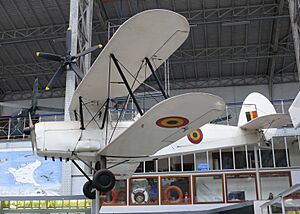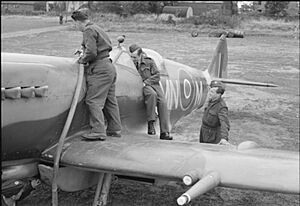Michel Donnet facts for kids
Quick facts for kids
Michel Donnet
|
|
|---|---|
| Nickname(s) | "Mike" |
| Born | 1 April 1917 Richmond, Surrey, England |
| Died | 31 July 2013 (aged 96) Waterloo, Belgium |
| Allegiance | Belgium United Kingdom |
| Service/ |
Belgian Army (1938–40) Royal Air Force (1941–45) Belgian Air Force (1945–75) |
| Years of service | 1938–1975 |
| Rank | Lieutenant General |
| Commands held | No. 350 Squadron RAF (1944) No. 64 Squadron RAF (1942) |
| Battles/wars | Second World War
|
| Awards | Grand Officer of the Order of the Crown Croix de Guerre Commander of the Royal Victorian Order (United Kingdom) Distinguished Flying Cross (United Kingdom) Knight of the Legion of Honour (France) |
Michel G. L. "Mike" Donnet CVO, DFC (born April 1, 1917 – died July 31, 2013) was a brave Belgian pilot. He flew for the Belgian Army and the British Royal Air Force (RAF) during World War II. He was very skilled, shooting down four enemy planes. He became a high-ranking officer, a wing commander, in the RAF. After the war, he joined the Belgian Air Force. He held many important leadership roles before he retired in 1975.
Contents
Michel Donnet and World War II
Michel Donnet joined the Aviation Militaire Belge (Belgian Army Air Force) on March 1, 1938. He became a sergeant-pilot on March 26, 1939. He agreed to serve for three more years starting March 1, 1940. Donnet flew Renard R.31 planes for scouting missions. His unit was the 9th Escadrille of the First Aviation Regiment.
When Germany invaded Belgium on May 10, 1940, he flew many missions. After 18 days of fighting, Belgium surrendered. Donnet was captured by German soldiers on June 1, 1940. He was held as a POW in camps in Germany and France. He was sent back to Belgium on January 10, 1941.
Escape to Freedom
After being released in German-occupied Belgium, Donnet met his old friend, pilot Léon Divoy. They quickly decided to build a plane to escape to England. They looked for a propeller and found one still attached to a complete plane. It was a Stampe et Vertongen SV-4B (OO-ATD). This plane belonged to Baron Thierry d'Huart. It was kept in a locked hangar at his home, the Chateau de Terblock, near Brussels.
Even though German troops were at the chateau, Donnet and Divoy spent four months planning their escape. Many trusted friends and the Belgian Resistance helped them. They rode bicycles for three hours at night from Brussels to the chateau and back. They made their own flying instruments and found rare gasoline. They also tested all their systems carefully.
Divoy won a coin toss to be the pilot of the SV-4B. But the plane had two sets of controls, so Donnet could help him fly. On May 19, 1941, they tried to fly, but the engine would not start. They had to stop that first attempt. After more work, they tried again. Finally, at 2:45 AM on July 5, 1941, they took off. They flew west-north-west towards the coast.
They barely avoided a searchlight. Then the engine stopped, but luckily it started again. After about two hours of flying, they saw land as the sun rose. But the land did not look like their planned destination in Kent, England. The engine started running roughly, so they landed in the nearest open field. They quickly found out they were in England. They walked to the nearest police station in Thorpe-le-Soken, Essex.
The Stampe SV-4B plane was later painted in camouflage. It was used by the RAF in two squadrons. In 1945, it was returned to its owner in Belgium.
Joining the RAF
On July 26, 1941, Donnet was accepted into the RAF Volunteer Reserve. The next day, he and Léon Divoy joined No. 61 OTU (Operational Training Unit). This was at RAF Heston. There, as a Pilot Officer, he learned to fly Spitfire planes. On September 7, 1941, he was briefly sent to No. 143 Squadron RAF.
Flying with No. 64 Squadron
On September 15, 1941, Donnet was sent to 64 Squadron at RAF Turnhouse. He flew Spitfire Mk.II planes on patrols. He also protected shipping convoys in the North Sea. Sometimes, he was sent to RAF Drem. On November 17, 1941, the squadron moved to RAF Hornchurch. There, they flew Spitfire Mk. Vs. Donnet spent his time practicing dogfights. He also escorted bomber planes and attacked German airfields in Belgium. He fought against Focke-Wulf Fw 190 planes.
In April 1942, the squadron moved to RAF Rochford (Southend). On April 4, Donnet saw his friend Léon Divoy crash with another Spitfire. Divoy parachuted out and was a prisoner of war for the rest of the war. Donnet flew more missions against Fw 190s from RAF Hornchurch. In July 1942, he started flying Spitfire Mk. IXs. On July 21, 1942, he received the Belgian Croix de Guerre award. Soon after, he shot down his first confirmed Fw 190 enemy plane.
On August 19, 1942, he helped protect American B-17 bombers during the Dieppe Raid. On September 2, 1942, he was put in charge of 'A' flight of 64 Squadron. On February 19, 1943, he received the DFC (UK) award. This was after he had flown 100 missions. On March 26, 1943, he was promoted to Acting Squadron Leader of 64 Squadron. He flew Spitfire Mk. Vs from RAF Ayr. His duties included escorting planes and training for landing on ship decks. On August 7, 1943, the squadron moved to RAF Friston. On November 5, 1943, he went to a course for Fighter Leaders. Then, on November 19, 1943, he went to No. 52 OTU.
Leading No. 350 Squadron
On March 23, 1944, Donnet became the Squadron Leader of No. 350 Squadron. This squadron was made up of Belgian pilots. They flew Spitfire IXs from RAF Peterhead. In April, they moved to RAF Friston. On June 6, 1944, during the Normandy landings (D-Day), he led the squadron. They provided constant fighter protection over the beach where the troops landed.
In July 1944, the squadron moved to RAF Westhampnett. On August 8, 1944, he moved with the squadron to RAF Hawkinge. They flew Spitfire XIV planes. They used these planes to fight against V-1 flying bombs. On September 3, 1944, he learned that Belgium had been freed. The next day, he led a group of 12 Spitfires over Brussels to celebrate. On September 29, 1944, the squadron moved to RAF Lympne.
Becoming a Wing Commander
On October 23, 1944, Donnet became the Wing Commander of No. 132 Squadron and No. 441 Squadron. This was at RAF Hawkinge, and they flew Spitfire IXs. In February 1945, he became Wing Commander of three RAF squadrons: No. 64 Squadron, No. 126 Squadron, and No. 234 Squadron. They were based at RAF Bentwaters. They flew Mustang III planes to escort bombers.
In August 1945, he studied at the RAF Staff College. On March 21, 1945, he was sent to RAF Fersfield with No. 64 Squadron and No. 132 Squadron. They escorted Mosquito planes of No. 140 Wing. This was for Operation Carthage over Copenhagen. During the war, Donnet flew 375 missions. He shot down four enemy planes for sure. He also damaged at least five more.
After the War
After the war, Michel Donnet was sent to the Belgian Ministry of Defense. His job was to help reorganize the Belgian Air Force. He also helped update it with new planes like the Gloster Meteor and Republic F-84. He then led the headquarters of No. 83 Group RAF. He became the commander of Allied Air Forces Central Europe. After that, he was Commander of the headquarters of RAF Second Tactical Air Force.
He became the head of the committee for the NADGE project. This was the Integrated NATO Air Defense System. Later, he became a Military Attaché at the Belgian Embassy in London. He was also a member of the Military Committee of NATO. On July 1, 1975, he retired from the Belgian Air Force. He was a lieutenant general. He had flown for over 5,000 hours in his career.
Awards and Decorations
Michel Donnet received many awards for his bravery and service:
- Grand Officer of the Order of Leopold with palm
- Grand Officer of the Order of the Crown with palm
- Commander of the Royal Order of Leopold II
- War Cross WWII with 4 palms
- Escaper's Cross
- WWII Commemorative Medal with swords
- Prisoner of War Medal
- 1940–1945 Military Combatant's Medal
- Military Cross, first class
- Commander of the Royal Victorian Order (UK)
- Knight of the Legion of Honour (France)
- Distinguished Flying Cross (UK)
- Air Crew Europe Star with rosette (UK)
- Atlantic Star with rosette (UK)
- 1939–1945 Star (UK)
- Defence Medal (UK)
- War Medal 1939-1945 (UK)
- Medal of a Liberated France (France)
Personal Life
Michel Donnet was the son of Jean Georges Hyacinthe Marie Donnet and Mariquita Jeanne Françoise Eyben. His father, Jean Donnet, worked with refrigeration. He also served in World War One as a volunteer in the Belgian army. Michel Donnet married Jacqueline 'Kiki' Gautier. They had four daughters: Anne, Marie, Therese, and Claire. They also had one son named Jean. Michel Donnet passed away on July 31, 2013, in Waterloo, Belgium.




